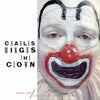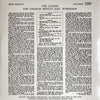



Charles Mingus - The Clown (Mono)
Charles Mingus - DoubleBass [click here to see more Vinyl featuring Charles Mingus]
Curtis Porter - Alto & Tenor sax
Jimmy Kneeper - Trombone
Wade Legge - Piano
Donnie Richmond - Drums
Jean Shepherd - Narration (B2)
Written by Charles Mingus
1 LP, standard sleeve
Original analog Master tape : YES
Heavy Press : 180g
Record color : black
Speed : 33 RPM
Size : 12'’
Mono
Studio
Record Press : Pallas
Label : Speakers Corner
Original Label : Atlantic
Recording: Februay and March 1957 in New York City by Tom Dowd and Larry Hiller
Produced by Nesuhi Ertegün
Originally released in 1957
Reissued in 2016
Tracks :
Side A :
- Haitian Flight Song
- Blue Cee
Side B :
- Reincarnation of a Lovebird
- The Clown
Reviews :
« The Clown was Charles Mingus' second masterpiece in a row, upping the already intense emotional commitment of Pithecanthropus Erectus and burning with righteous anger and frustration. With Pithecanthropus, Mingus displayed a gift for airtight, focused arrangements that nonetheless allowed his players great freedom to add to the established mood of each piece. The Clown refines and heightens that gift; instead of just writing heads that provide launch points for solos, Mingus tries to evoke something specific with every piece, and even his most impressionistic forays have a strong storytelling quality. In fact, The Clown's title cut makes that explicit with a story verbally improvised by Jean Shepherd (yes, the same Jean Shepherd responsible for A Christmas Story) from a predetermined narrative. There are obvious jazz parallels in the clown's descent into bitterness with every unresponsive, mean-spirited audience, but the track is even more interesting for the free improvisations led by trombonist Jimmy Knepper, as the group responds to Shepherd's story and paints an aural backdrop. It's evidence that Mingus' compositional palette was growing more determinedly modern, much like his increasing use of dissonance, sudden tempo changes, and multiple sections. The Clown introduced two of Mingus' finest compositions in the driving, determined "Haitian Fight Song" and the '40s-flavored "Reincarnation of a Lovebird," a peaceful but melancholy tribute to Charlie Parker; Mingus would return to both throughout his career. And, more than just composing and arranging, Mingus also begins to take more of the spotlight as a soloist; in particular, his unaccompanied sections on "Haitian Fight Song" make it one of his fieriest moments ever. Mingus may have matched the urgency of The Clown on later albums, but he never quite exceeded it. » AllMusic Review by Steve Huey
« This is a lovely remastering of one of Mingus’ best albums – his 1957 mono release.
These four tracks were all composed and performed by the amazing bassist Mingus, and have been reissued on various poor discs (some with terrible cover art), so it is wonderful to finally have this Mingus masterpiece in a really good version that preserves everything that happened in that studio in March of 1957. The original packaging includes detailed notes on the back by Nat Hentoff. He spends a lot time on the volatile personality of Mingus. Mingus said, “Just because I’m playing jazz, I don’t forget about me…My music is alive and it’s about the living and the dead, about good and evil. It’s angry, yet it’s real because it knows it’s angry.”
The folk spirit of “Haitian Fight Song” open the first side. It also has a bit of the old black church in it. “Blue Cee” is a standard blues which Mingus feels has some Basie and church-like feelings in it. “Reincarnation of a Lovebird” on the second side recalls Mingus’ relationship with Charlie Parker, which was also volatile. It has a mournful sort of mood.
The last track, “The Clown,” (at 12 1/2 minutes) features the narration of the great monologist Jean Shepard. Mingus says he was playing a little tune on the piano that sounded happy. Then he hit a dissonance, and decided the piece had to have two parts. He told the story of the clown to Jean Shepard, about a character who tried to please people like most jazz musicians, but nobody liked him until he was dead. Every time the group performed it live, Shepard improvised and changed the story, just like a jazz improvisor. He even created an ending which leaves it up to the listener rather than explaining that the clown killed himself.
This was recorded by Tom Dowd and Larry Hiller and supervised by Nesuhi Ertegun. It is undoubtedly one of the great Mingus sessions, with excellent fidelity of all five instruments, and probably a must-have for all jazz collectors. » John Henry, Audiophile Audition, Nov 15, 2016
The Clown tells the story of a clown "who tried to please people like most jazz musicians do, but whom nobody liked until he was dead. My version of the story ended with his blowing his brains out with the people laughing and finally being pleased because they thought it was part of the act. I liked the way Jean changed the ending; leaves it more up to the listener." According to a later biography, Mingus was a fan of Shepard's radio show on WOR, and outlined a concept for Shepard but encouraged him to elaborate and improvise. » Gene Santoro, Myself When I am Real: The Life and Music of Charles Mingus. Oxford University Press
Who hasn't got an ancient, worn-out copy of "The Clown" on his shelf, with a tatty cover and torn inner sleeve? Or maybe one of the rare re-releases made of cheap, thin vinyl with dreadful graphic art? And if you haven't heard this gem for a long time, despite the flood of Mingus LPs, CDs and downloads on the market, then you really should seize this opportunity to do so.
"The Clown" was, and still is, an absolute must-have for every jazz collector. The small ensemble, only five musicians, came into the New York Atlantic Records studio in March 1957 to record music exclusively composed by the double bassist. Over the next 15 years, three of them were to be heard in numerous concerts with other ensembles. But the original recordings on this LP were the most deeply concentrated, the most versatile, and quite simply the best of all. The more so because the label attached great importance to optimal studio conditions and allowed the instrumentalists plenty of time to make the recordings.
Ratings :
Allmusic : 5 / 5 , Discogs :



